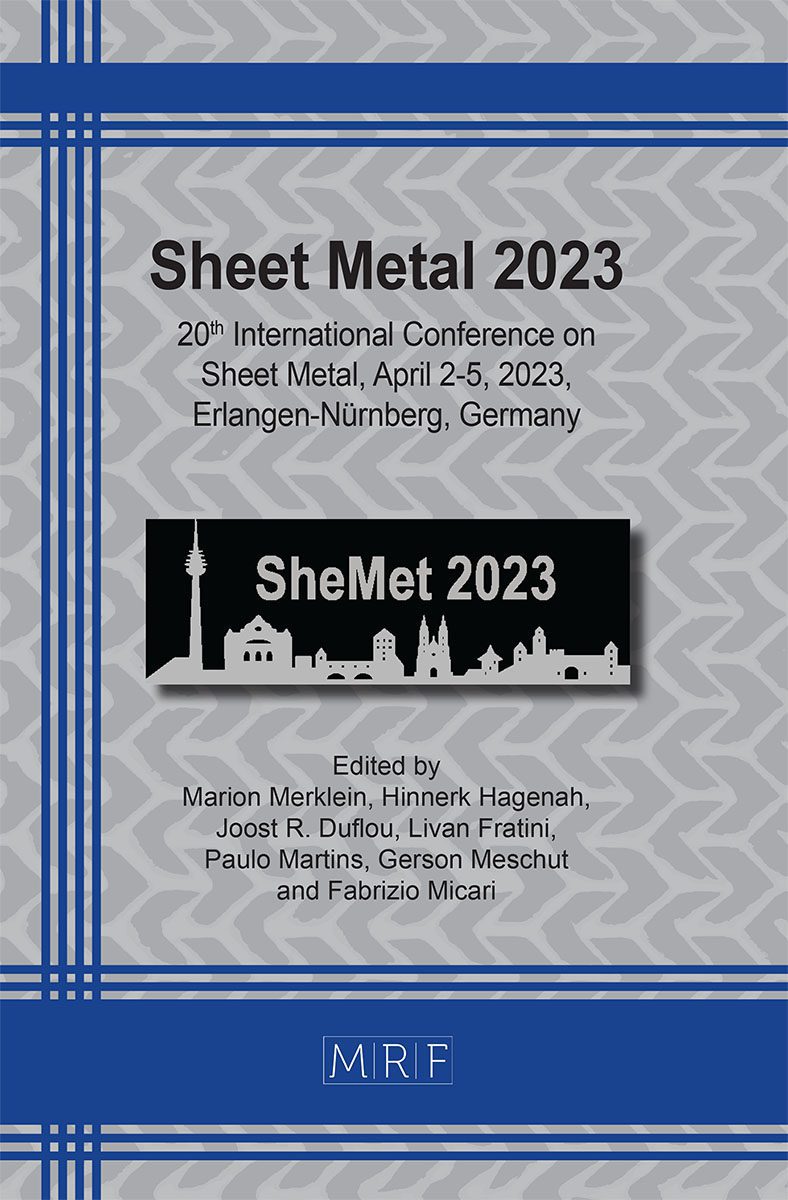Effect of process variables on interface friction characteristics in strip drawing of AA5182 alloy in warm forming temperature range
Archit Shrivastava, D. Ravi Kumar
download PDFAbstract. Warm forming is widely used to enhance formability of aluminum alloy sheets in order to manufacture components with complex shapes. However, forming of aluminum alloy sheets by various sheet metal forming processes such as deep drawing and stretch forming involves sliding, drawing or stretching of sheet materials over the tool surfaces. Warm forming results in change of frictional characteristics at the tool-blank interface during forming. Higher friction leads to poor formability, non-uniform strain distribution, higher forming load, and poor surface finish of the component. So it is important to investigate the effect of process variables on friction at the interface in warm forming of aluminum alloy sheets. In this work, the tribological behavior of an Al-Mg-Mn alloy (AA5182) has been studied by performing strip drawing experiments in the warm forming temperature range (100-250 °C) in lubricated condition. Experiments were conducted to investigate the effect of temperature, normal force, and drawing speed on the coefficient of friction. A significant impact on the friction coefficient is observed by the change in boundary conditions as a result of variation in process variables with temperature being the most influential. The results have been compared with frictional characteristics in strip drawing at ambient temperature.
Keywords
Metal Forming, Friction, Strip Drawing Test
Published online 3/17/2023, 8 pages
Copyright © 2023 by the author(s)
Published under license by Materials Research Forum LLC., Millersville PA, USA
Citation: Archit Shrivastava, D. Ravi Kumar, Effect of process variables on interface friction characteristics in strip drawing of AA5182 alloy in warm forming temperature range, Materials Research Proceedings, Vol. 25, pp 423-430, 2023
DOI: https://doi.org/10.21741/9781644902417-52
The article was published as article 52 of the book Sheet Metal 2023
![]() Content from this work may be used under the terms of the Creative Commons Attribution 3.0 licence. Any further distribution of this work must maintain attribution to the author(s) and the title of the work, journal citation and DOI.
Content from this work may be used under the terms of the Creative Commons Attribution 3.0 licence. Any further distribution of this work must maintain attribution to the author(s) and the title of the work, journal citation and DOI.
References
[1] P. Rambabu, N. Eswara Prasad, V.V. Kutumbarao, R.J.H. Wanhill, Aluminium Alloys for Aerospace Applications, in: N. Prasad, R. Wanhill (Eds.), Aerospace Materials and Material Technologies, Indian Institute of Metals Series. Springer, Singapore, 2017, 29–52. https://doi.org/10.1007/978-981-10-2134-3_2
[2] J.C. Benedyk, Aluminum alloys for lightweight automotive structures, in: P.K. Mallick (Eds.), Materials, Design and Manufacturing for Lightweight Vehicles, Woodhead Publishing Series in Composites Science and Engineering, 2010, 79-113. https://doi.org/10.1533/9781845697822.1.79
[3] Z. Marciniak, J.L. Duncan and S.J. Hu, Mechanics of Sheet Metal Forming, Second ed., Butterworth-Heinemann, 2002.
[4] T. Altan, A.E. Tekkaya (Eds.), Sheet metal forming: processes and applications, ASM international, 2012. https://doi.org/10.31399/asm.tb.smfpa.9781627083171
[5] M. Tisza and Z.S. Lukacs, High strength aluminium alloys in car manufacturing, IOP Conf. Ser.: Mater. Sci. Eng., 418 (2018) 012033. https://doi.org/10.1088/1757-899X/418/1/012033
[6] D.H., Jang, W.J. Kim, Warm Temperature Deformation Behavior and Processing Maps of 5182 and 7075 Aluminum Alloy Sheets with Fine Grains, Met. Mater. Int., 24 (2018) 455–463. https://doi.org/10.1007/s12540-018-0061-3
[7] D. Raja Satish, D. Ravi Kumar and M. Merklein, Effect of temperature and punch speed on forming limit strains of AA5182 alloy in warm forming and improvement in failure prediction in finite element analysis: A case study, The Journal of Strain Analysis for Engineering Design, 52:4 (2017) 258-273. https://doi.org/10.1177/0309324717704995
[8] J. Noder, R. George, C. Butcher, and M. J. Worswick, Friction characterization and application to warm forming of a high strength 7000-series aluminum sheet, Journal of Materials Processing Technology, 293 (2021) 117066. https://doi.org/10.1016/j.jmatprotec.2021.117066
[9] V. Prakash, D. Ravi Kumar, Performance evaluation of bio-lubricants in strip drawing and deep drawing of an aluminium alloy, Advances in Materials and Processing Technologies, 8:1 (2020) 1044-1057. https://doi.org/10.1080/2374068X.2020.1838134
[10] R. Lachmayer, B. Behrens, T. Ehlers, P. Müller, P. Althaus, M. Oel, E. Farahmand, P.C. Gembarski, H. Wester, S. Hubner, Process-Integrated Lubrication in Sheet Metal Forming, J. Manuf. Mater. Process, 6 (2022) 121. https://doi.org/10.3390/jmmp6050121
[11] J. Tenner, K. Andreas, A. Radius, M. Merklein, Numerical and experimental investigation of dry deep drawing of aluminum alloys with conventional and coated tool surfaces, Procedia engineering, 207 (2017) 2245-2250. https://doi.org/10.1016/j.proeng.2017.10.989
[12] K. R. Januszkiewicz, A. R. Riahi, and S. Barakat, High temperature tribological behaviour of lubricating emulsions, Wear, 256 (2004) 1050-1061. https://doi.org/10.1016/j.wear.2003.06.001
[13] G. Maculotti, E. Goti, G. Genta, L. Mazza, M. Galetto, Uncertainty-based comparison of conventional and surface topography-based methods for wear volume evaluation in pin-on-disc tribological test, Tribology International, 165 (2022) 107260. https://doi.org/10.1016/j.triboint.2021.107260
[14] S. Swirad, P. Pawlus, The Effect of Ball Burnishing on Tribological Performance of 42CrMo4 Steel under Dry Sliding Conditions. Materials, 13:9 (2020) 2127. https://doi.org/10.3390/ma13092127
[15] T. Bjork, J. Bergström, S. Hogmark, Tribological simulation of aluminium hot extrusion, Wear, 224:2 (1999) 216-225. https://doi.org/10.1016/S0043-1648(98)00332-9
[16] J. Lu, Y. Song, L. Hua, P. Zhou, G. Xie, Effect of temperature on friction and galling behavior of 7075 aluminum alloy sheet based on ball-on-plate sliding test, Tribology International, 140 (2019) 105872. https://doi.org/10.1016/j.triboint.2019.105872
[17] P. Schwingenschlogl, M. Weldi and M. Merklein, Investigation of the influence of process parameters on adhesive wear under hot stamping conditions, J. Phys.: Conf. Ser. 896 (2017) 012048. https://doi.org/10.1088/1742-6596/896/1/012048
[18] G.E. Dieter, D. Bacon, Mechanical metallurgy, SI Metric ed., McGraw-hill, New York, 1988, 544-545.































